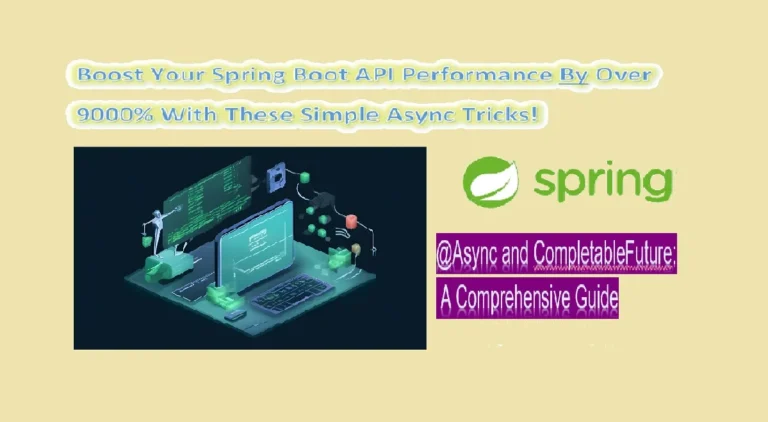Sending a high volume of emails is a common requirement for many applications. However, care must be taken to ensure good performance and deliverability when sending bulk emails. The Spring Framework (Spring Email) provides many options to optimize and scale email delivery.
In this article, we’ll explore several strategies to improve the performance of sending bulk emails using Spring Mail, a powerful and flexible email sending library integrated with the Spring framework.
Here are some tips for improving performance when sending bulk emails with Spring Mail:
- Use a thread pool to send emails asynchronously. Spring provides a SimpleMailMessage class that can be used with a Java ExecutorService to send emails in a multithreaded manner. This prevents each email from blocking while it’s being sent.
- Use a mailing service like Amazon SES or Mailgun instead of a local SMTP server. These services are optimized for sending large volumes of email.
- Enable connection pooling in the JavaMailSender. This reuses SMTP connections instead of creating a new connection for every email.
- Use batching to send multiple emails per request. Spring Batch provides support for this. You would collect emails into batches before sending to the mail server.
- Enable compression on the SMTP connection. Many servers support TLS compression to reduce bandwidth usage.
- Profile the application to identify any bottlenecks. Slowdowns could be from database queries, template rendering, or connections not closing properly.
- Consider using a database queue like RabbitMQ to decouple email creation from sending. Emails can be queued asynchronously and then sent by background workers.
- Cache parts of the email generation process like templates, images, and static content. This avoids redundant operations when sending bulk email.
- Upgrade to the latest Spring and JavaMail versions for performance enhancements

Why Optimize Bulk Email Delivery?
There are a few key reasons why optimizing bulk email delivery matters:
- Slow performance – Sending one email at a time is extremely slow for large volumes. Optimizations dramatically speed up email sending.
- Deliverability – Sending a huge batch without optimizations can overwhelm recipients and providers, leading to failures or spam filtering. Optimizations improve deliverability.
- Resource usage – Sending high volumes monopolizes bandwidth, CPU, memory and connections. Optimizations reduce infrastructure resource usage.
- Cost savings – When using cloud mailing services, optimizations allow you to send more emails for the same cost.
Techniques for Optimization
Let’s explore some key optimization techniques:
1. Use Asynchronous Sending
Asynchronous email sending allows your application to send emails in the background without blocking the main thread. This is particularly important when dealing with bulk emails to ensure that the application remains responsive. Spring provides the @Async annotation to facilitate asynchronous execution.
public class AsynchronousEmailSender {
private static final int THREAD_POOL_SIZE = 10;
private ExecutorService threadPool = Executors.newFixedThreadPool(THREAD_POOL_SIZE);
public void sendEmail(EmailMessage emailMessage) {
threadPool.submit(() -> {
sendEmailSynchronously(emailMessage);
});
}
private void sendEmailSynchronously(EmailMessage emailMessage) {
// Send the email using synchronous methods
}
}
2. Batch Processing
Sending emails individually can lead to unnecessary overhead in terms of opening and closing connections. Batch processing allows you to send emails in groups, reducing this overhead.
By sending emails in batches, you optimize the utilization of resources and improve the overall efficiency of the email sending process.
public class BatchEmailSender {
private static final int BATCH_SIZE = 100;
public void sendBatch(List<EmailMessage> emailMessages) {
List<List<EmailMessage>> batches = splitEmailsIntoBatches(emailMessages, BATCH_SIZE);
for (List<EmailMessage> batch : batches) {
sendBatchSynchronously(batch);
}
}
private void sendBatchSynchronously(List<EmailMessage> emailMessages) {
// Send the batch of emails using synchronous methods
}
private List<List<EmailMessage>> splitEmailsIntoBatches(List<EmailMessage> emails, int batchSize) {
List<List<EmailMessage>> batches = new ArrayList<>();
int currentIndex = 0;
while (currentIndex < emails.size()) {
List<EmailMessage> batch = emails.subList(currentIndex, Math.min(currentIndex + batchSize, emails.size()));
batches.add(batch);
currentIndex += batchSize;
}
return batches;
}
}
3. Connection Pooling
Opening a brand new SMTP connection for every email is tremendously inefficient. Enable JavaMail connection pooling to reuse connections:
sender.getJavaMailProperties().put("mail.smtp.connectionpool.enabled", true);Connection pooling helps in reusing existing connections, reducing the overhead of creating new connections for each email, and enhancing the overall performance of your application.
4. Optimize Message Construction
Constructing email messages can be resource-intensive, and optimizing this process is essential for bulk email sending. Reusing instances of the MimeMessageHelper class can significantly improve performance.
public class EmailService {
@Autowired
private JavaMailSender javaMailSender;
public void sendEmail(String to, String subject, String body) {
// Reuse MimeMessageHelper instance
MimeMessage mimeMessage = javaMailSender.createMimeMessage();
MimeMessageHelper mimeMessageHelper = new MimeMessageHelper(mimeMessage);
// Set email details
mimeMessageHelper.setTo(to);
mimeMessageHelper.setSubject(subject);
mimeMessageHelper.setText(body, true);
// Send email
javaMailSender.send(mimeMessage);
}
}
By reusing the MimeMessageHelper instance, you minimize memory usage and processing time, contributing to a more efficient bulk email sending process.
5. Configure Timeout Values
Configuring timeout values is crucial to prevent your application from waiting indefinitely for email sending operations to complete. Adjust these values based on your network conditions and the responsiveness of your SMTP server.
@Configuration
public class MailConfig {
@Bean
public JavaMailSender javaMailSender() {
JavaMailSenderImpl mailSender = new JavaMailSenderImpl();
// Other configurations...
mailSender.setSession(session -> {
Properties props = session.getProperties();
props.put("mail.smtp.timeout", "5000"); // Set timeout to 5 seconds
props.put("mail.smtp.connectiontimeout", "5000"); // Set connection timeout to 5 seconds
});
return mailSender;
}
}
Fine-tuning timeout values ensures that your application maintains responsiveness even during email sending operations.
6. Use a Thread Pool
Sending each email sequentially results in very slow performance. Use a thread pool to send emails in parallel:
//Create a thread pool
ExecutorService executor = Executors.newFixedThreadPool(10);
//Send emails asynchronously
for(Email email : emails) {
executor.submit(new Runnable() {
public void run() {
mailSender.send(email);
}
});
}
//Shut down thread pool when done
executor.shutdown();Tune the thread pool size based on your infrastructure capabilities and SMTP server connections. Too many threads can overload systems.
7. Leverage Cloud Mailing Services
Instead of using a local SMTP server, use a cloud-based service optimized for sending high volumes of email:
- Amazon SES
- SendGrid
- Mailgun
- Mailjet
These services provide fast delivery speeds, automation, analytics, scalability and other optimizations.
For example:-
Amazon SES is designed to deliver billions of emails at scale. It handles email delivery speed optimizations, bouncing, and reputation management.
//Autowire the SES client @Autowired AmazonSimpleEmailService client; //Send email SendEmailRequest request = new SendEmailRequest() .withSource(sender) .withDestination(recipient) .withMessage(msg); client.sendEmail(request);
8. Monitor and Tune
Monitoring your application’s performance is crucial for identifying bottlenecks and areas for improvement. Spring Boot Actuator provides a set of production-ready features, including metrics, health checks, and more.
Use these metrics to analyze your application’s behavior and make informed decisions for tuning configurations. Adjust batch sizes, thread pool sizes, and other parameters based on the observed performance of your application.
Additional Best Practices
Here are some other tips:
- Profile – Profile code to identify bottlenecks like slow database queries.
- Tune configs – Adjust thread pools, batch sizes etc. based on load testing.
- Rate limit – Limit emails per second to avoid overwhelming systems.
- Stagger delivery – Spread emails over time to improve deliverability.
- Handle bounces – Handle bounces and remove invalid addresses.
- Allow unsubscribes – Make it easy for people to opt-out of future emails.
Key Takeaways
- Enable asynchronous sending with Spring for parallelism
- Leverage connection pooling for reuse
- Use batching to improve throughput
- Queue strategically to smooth spikes
- Compress emails to reduce size
- Upgrade components for latest performance
Frequently Asked Questions (FAQs) for Spring Email
Q: Why is asynchronous sending important for bulk emails?
A: Asynchronous sending allows your application to continue processing other tasks while emails are being sent in the background, ensuring responsiveness and improved user experience.
Q: What is the role of connection pooling in email sending?
A: Connection pooling helps in reusing existing SMTP connections, reducing the overhead of creating new connections for each email. This optimization enhances the overall performance of the email sending process.
Q: How does optimizing message construction improve performance?
A: Reusing instances of the MimeMessageHelper class minimizes memory usage and processing time, contributing to a more efficient bulk email sending process.
Q: Why configure timeout values for email sending?
A: Configuring timeout values prevents your application from waiting indefinitely for email sending operations to complete, ensuring that your application remains responsive.
Q: How can I monitor my application’s performance during bulk email sending?
A: Spring Boot Actuator provides production-ready features for monitoring, including metrics and health checks. Use these features to analyze your application’s behavior and make informed decisions for performance tuning.
Q: Should I use my own SMTP server or a mailing service?
A: It’s recommended to use a dedicated mailing service like SendGrid or Mailgun rather than your own SMTP server. Mailing services are designed to handle large email volumes with good deliverability.
Q: How can I ensure emails don’t get flagged as spam?
A: Proper formatting, authentication, IP reputation monitoring, and tools like SPF and DKIM help avoid the spam folder. Also stagger delivery over time.
Q: What thread pool size should I use?
A: Start with the number of CPU cores available. Load test and monitor resource utilization to find the optimal thread pool size.
Q: What batch size is best?
A: Larger batch sizes improve throughput but consume more memory. Start with 50-100 and test larger batches to find the optimal size.
Q: Should I queue emails or send them directly?
A: Queuing adds complexity but helps handle spikes in load. For consistently high volumes, direct sending with proper scaling may suffice.
Q: How do I handle invalid email addresses?
A: Verify addresses upfront when possible. Monitor bounces, remove bad addresses from your lists, and ensure future emails don’t go to invalid addresses.
Q: How can I load test my email setup?
A: Use tools like MailSlurp or MailTrap to generate test email addresses and model real email sending load. Monitor for bottlenecks.
For more insightful articles and in-depth guides on JAVA, Spring, Spring Boot and related topics, visit our homepage today.




